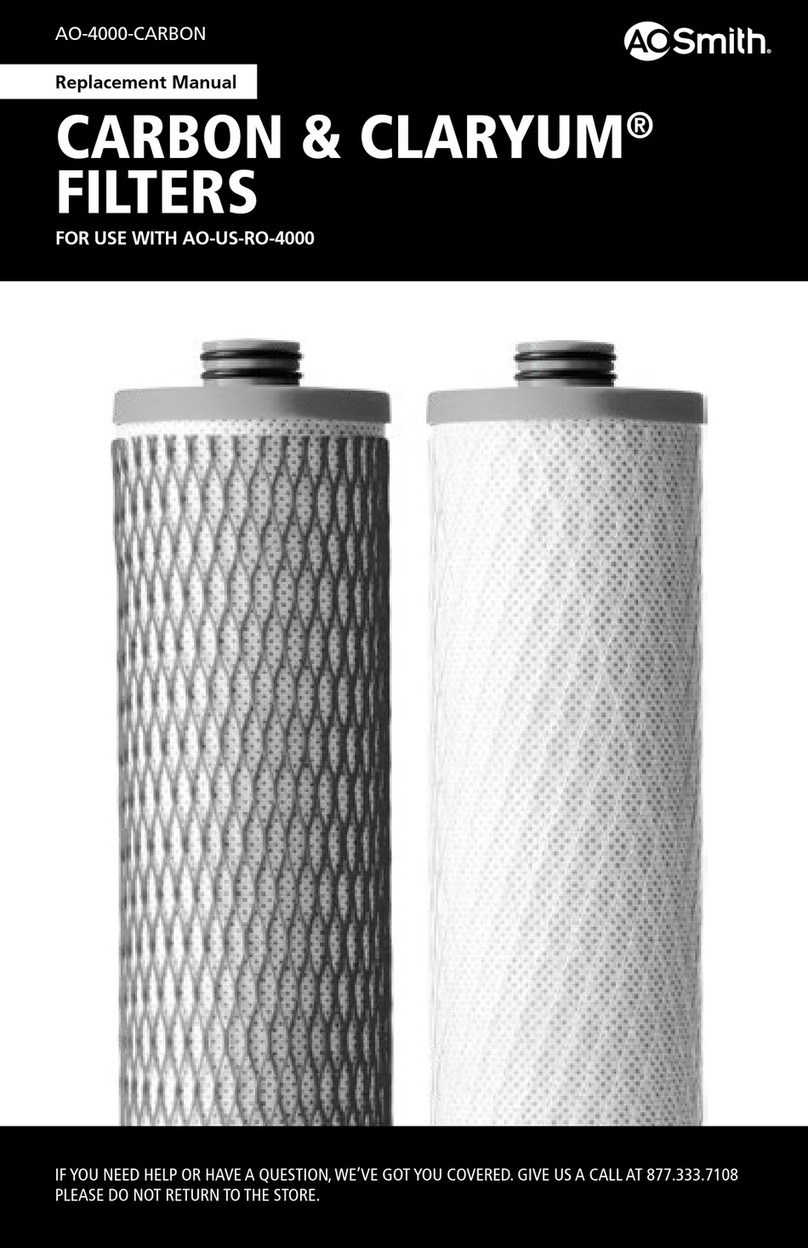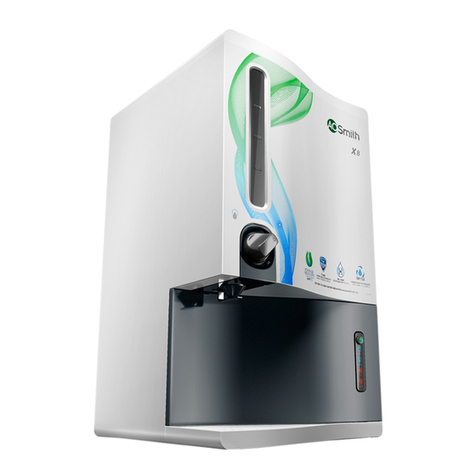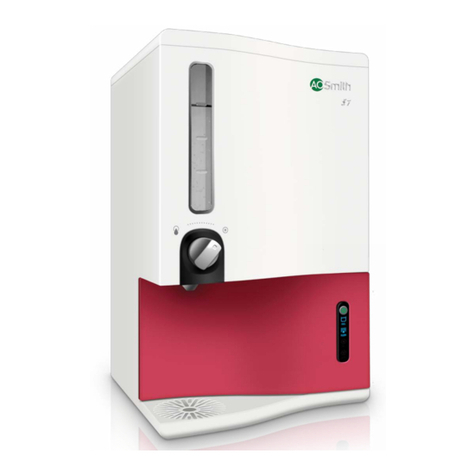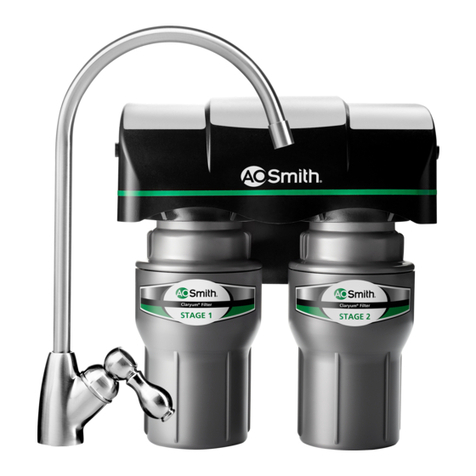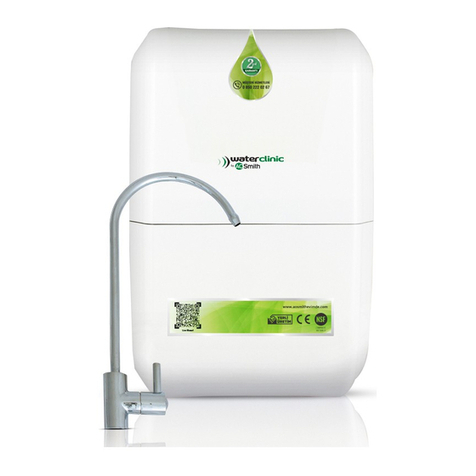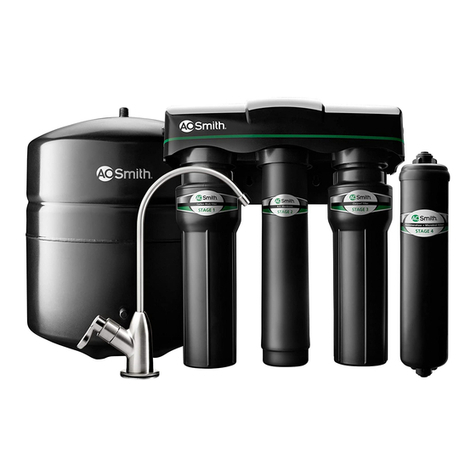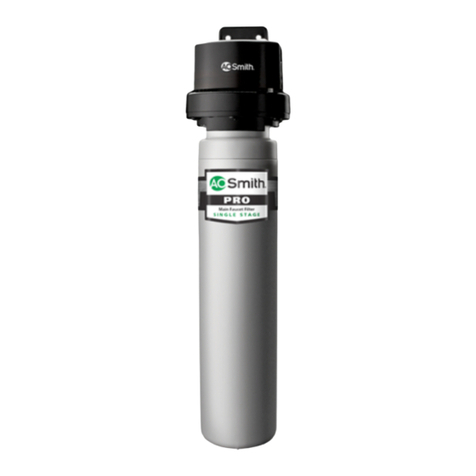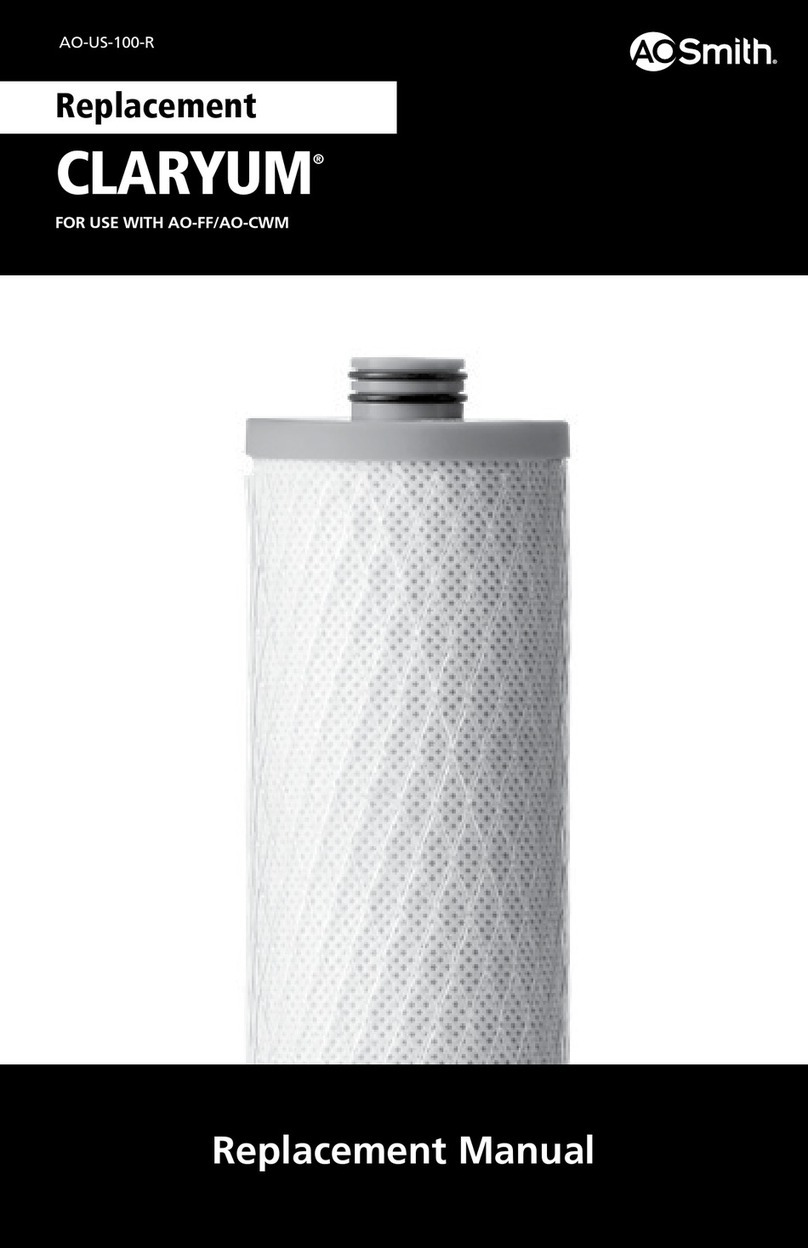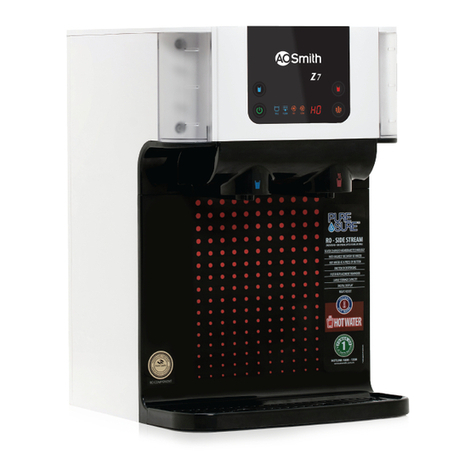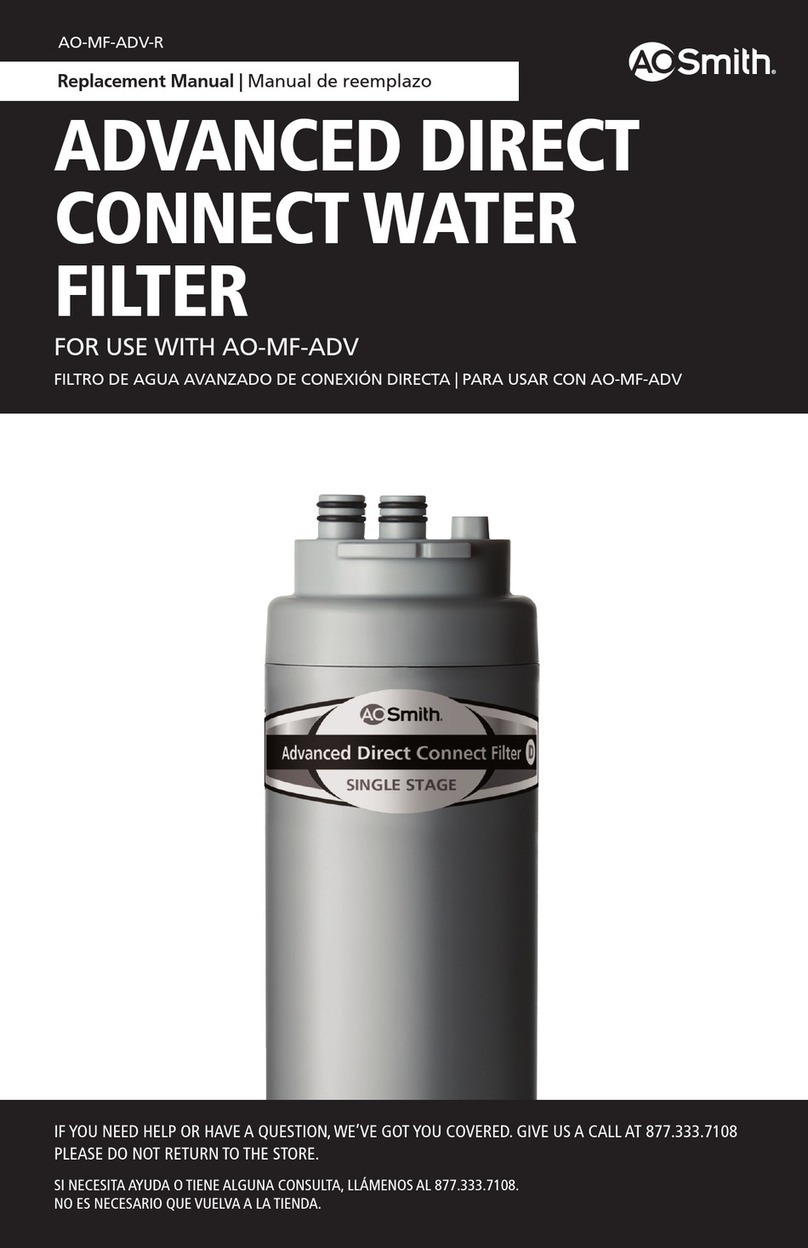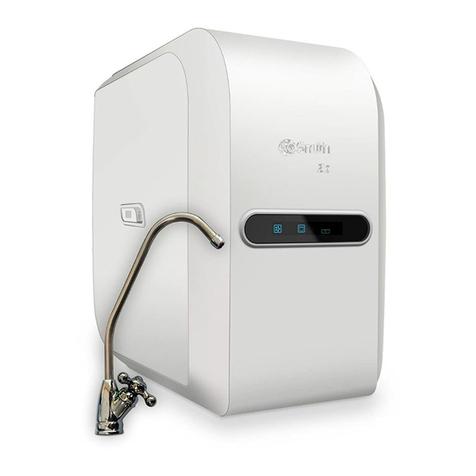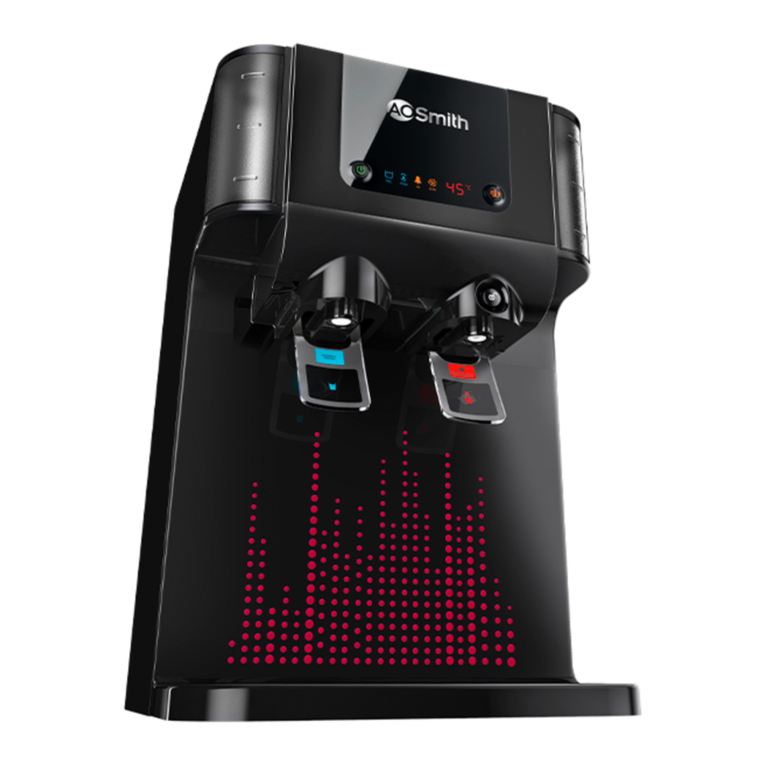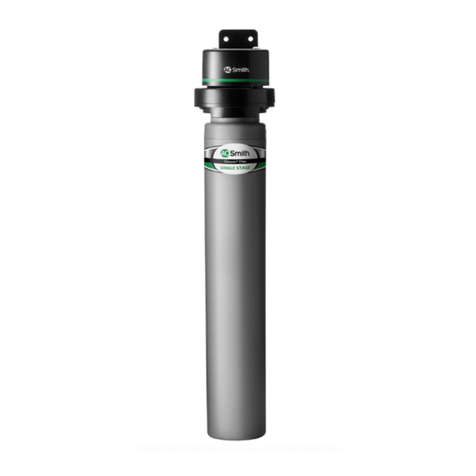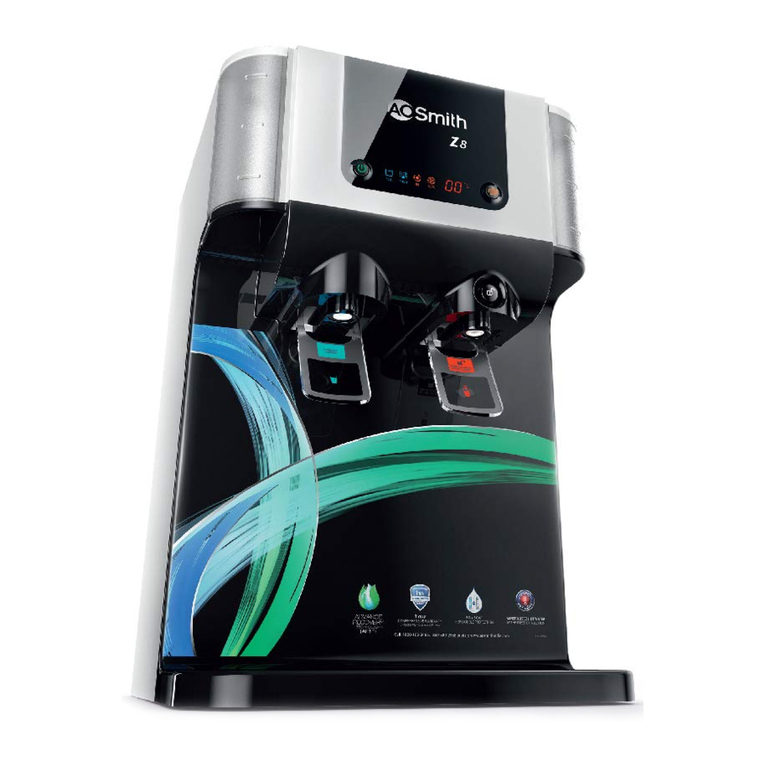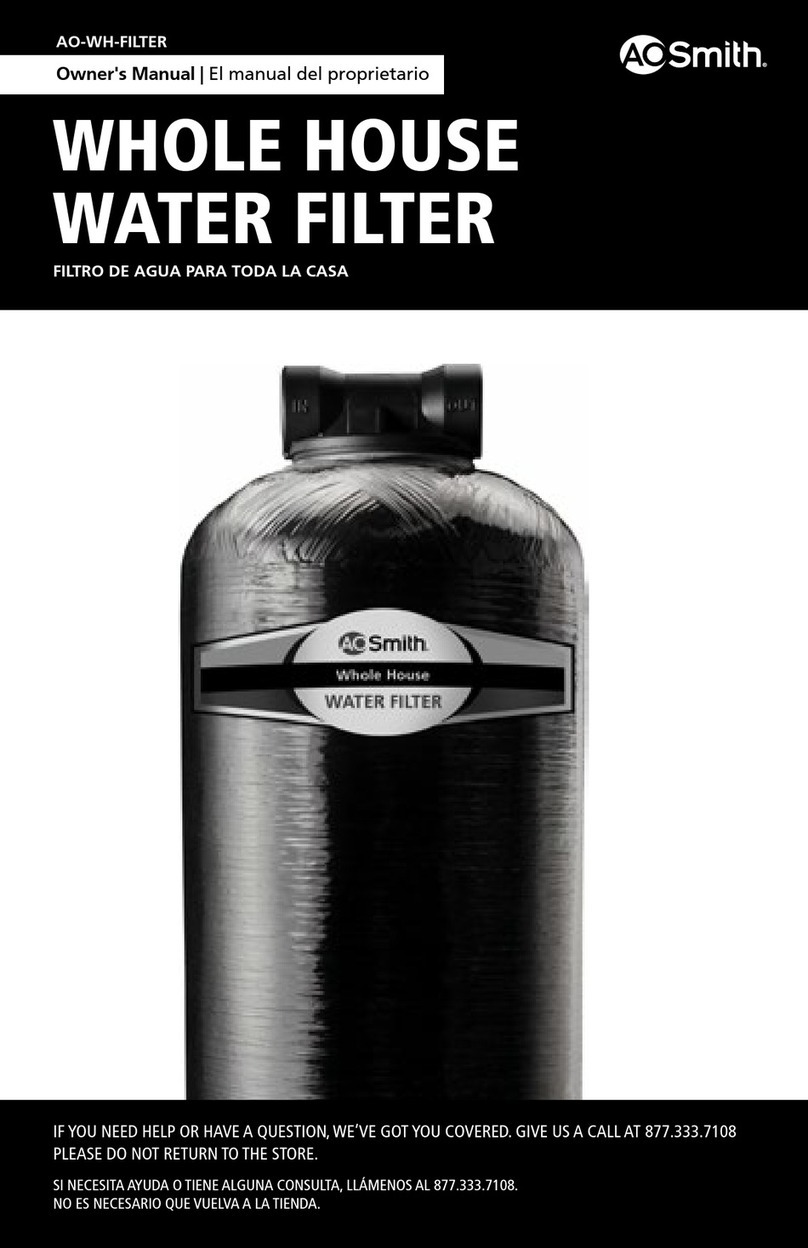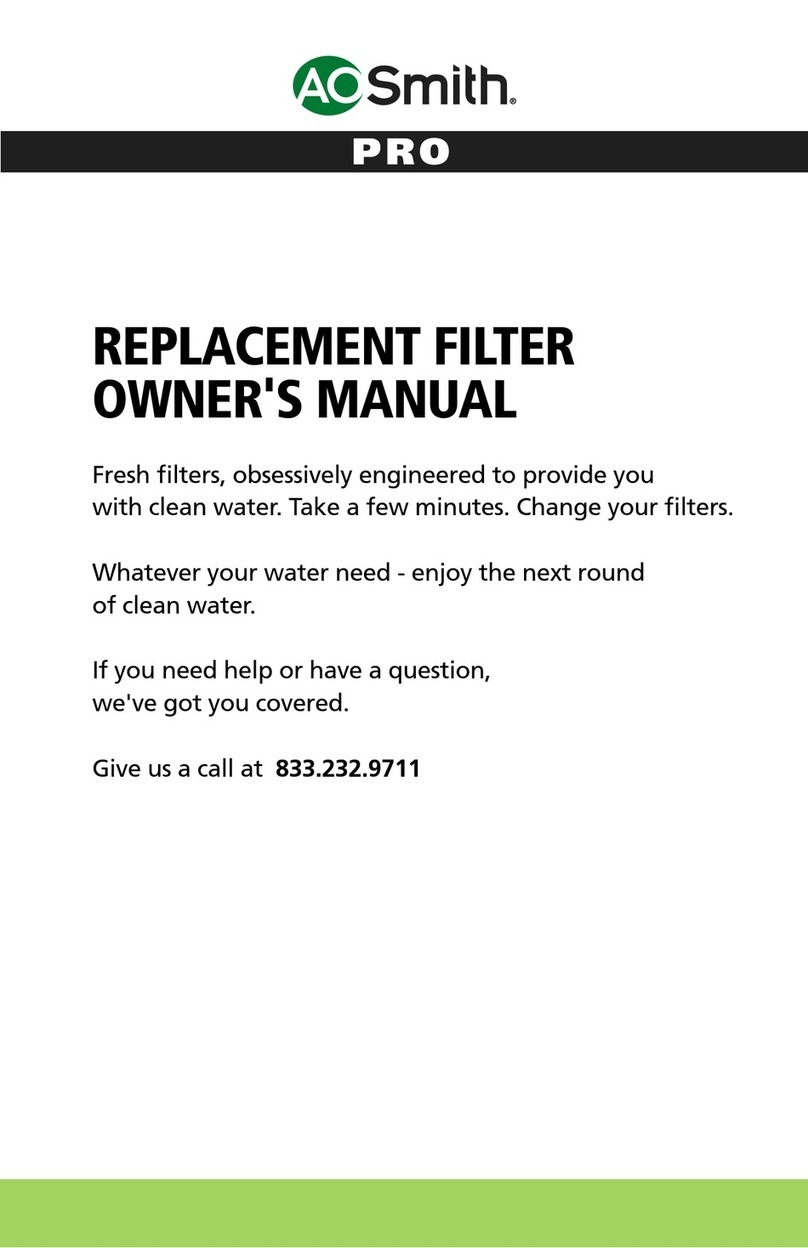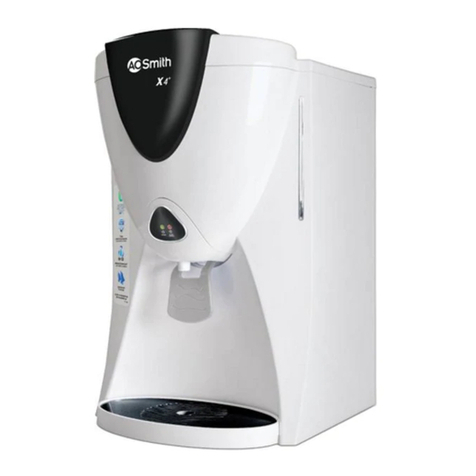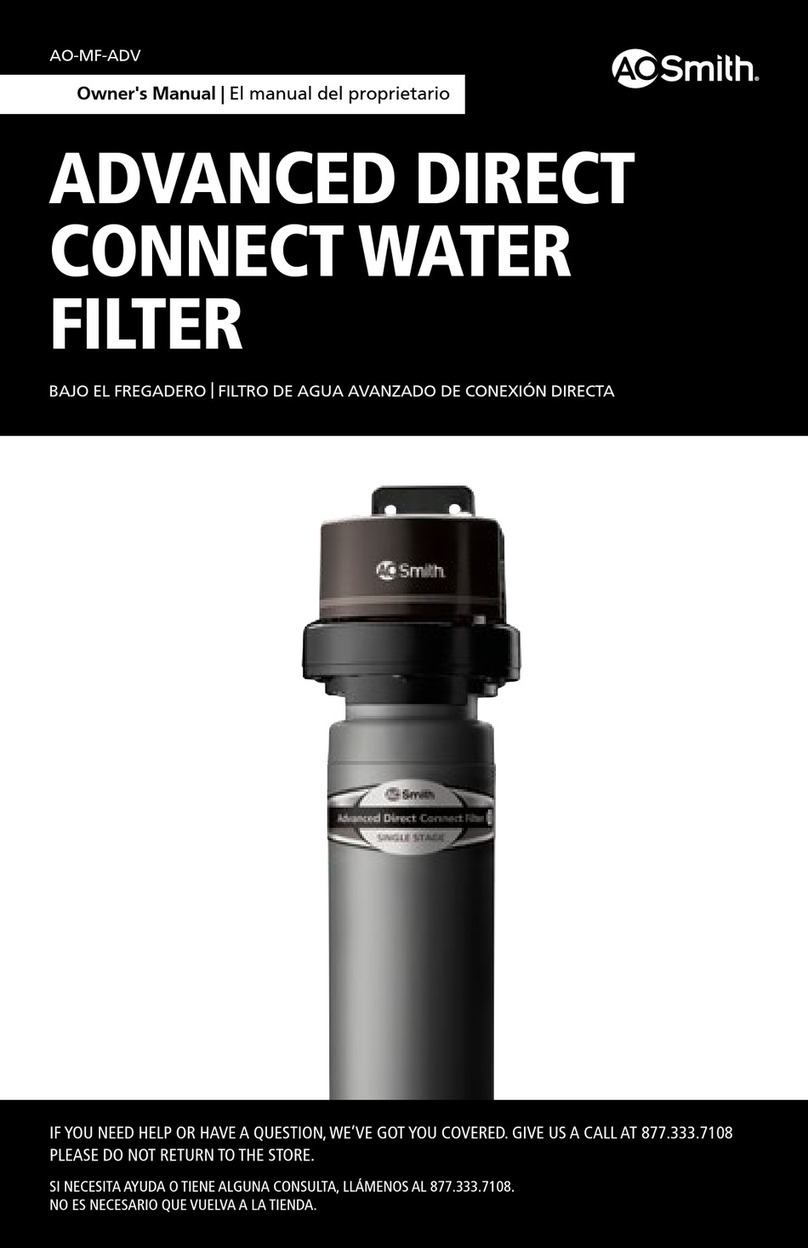
NEED HELP? GIVE US A CALL 833.232.9711 NEED HELP? GIVE US A CALL 833.232.9711
Arsenic (abbreviated As) is found naturally in some
well water. Arsenic in water has no color, taste or
odor. It is measured by a laboratory test. Public
water utilities must have their water tested for
arsenic. You can get the results from your water
utility. If you have your own well, you can have
the water tested. The local health department
or the state environmental health agency can
provide a list of certied labs. The cost is typically
$15 to $30. Information about arsenic in water
can be found on the internet at the U.S.
Environmental Protection Agency website:
epa.gov/safewater/arsenic.
There are two forms of arsenic:
pentavalent arsenic (As(V), As(+5), and arsenate)
and trivalent arsenic (also called As(III), As(+3), and
arsenite). In well water, arsenic may be pentavalent,
trivalent, or a combination of both. Special sampling
procedures are needed for a lab to determine what
type and how much of each type of arsenic is in the
water. Check with the labs in your area to see if they
can provide this type of service.
Reverse Osmosis (RO) water treatment systems
do not completely remove trivalent arsenic from
water. RO systems are very effective at removing
pentavalent arsenic.
A free chlorine residual will rapidly convert
trivalent arsenic to pentavalent arsenic. Other water
treatment chemicals such as ozone and potassium
permanganate will also change trivalent arsenic to
pentavalent arsenic. A combined chlorine residual
(also called chloramine) may not convert all the
trivalent arsenic. If you get your water from a public
water utility, contact the utility to nd out if free
chlorine or combined chlorine is used in the water
system. The AO-US-RO-MB-6000 System is designed
to remove pentavalent arsenic. It will not convert
trivalent arsenic to pentavalent arsenic. This System
was tested in a lab. Under testing conditions, system
reduced [0.30 mg/L (ppm) or 0.050 mg/L (ppm)]
pentavalent arsenic to 0.010 mg/L (ppm) (the USEPA
standard for drinking water) or less. The perfor-
mance of system may be different with your instal-
lation. Have the treated water tested for arsenic to
check whether the system is working properly.
The RO component of the AO-US-RO-MB-6000
System must be replaced every 2 years to ensure the
system will continue to remove pentavalent arsenic.
The component identication and locations where
you can purchase the component are listed in the
installation/operation manual.
This system has been tested for the treatment of water containing pentavalent arsenic
(also known as As(V), As(+5), or arsenate) at concentrations of 0.30 mg/L or less. This
system reduces pentavalent arsenic, but may not remove other forms of arsenic. This
system is to be used on water supplies containing a detectable free chlorine residual
at the system inlet or on water supplies that have been demonstrated to contain only
pentavalent arsenic. Treatment with chloramine (combined chlorine) is not sufcient to
ensure complete conversion of trivalent arsenic to pentavalent arsenic. Please see the
Arsenic Facts section of this Performance Data Sheet for further information.
This system is acceptable for treatment of inuent concentration of no more than
27 mg/L nitrate and 3 mg/L nitrite in combination measured as N; and is certied
for nitrate/nitrite reduction only for water supplies with a pressure of 40 psig
(275 kPa) or greater.
• Efciency rating is the percentage of
the inuent water to the system that is
available to the user as reverse osmosis
treated water under operating conditions
that approximate typical daily usage.
• Recovery rating is the percentage of the
inuent water to the membrane portion of
the system that is available to the user as
reverse osmosis treated water when the
system is operated without a Storage Tank
or when the Storage Tank is bypassed.
Arsenic Facts
Nitrate/Nitrite Removal
SYSTEM SPECIFICATIONS 15
As
33
Arsenic
NO3-
NO2-
Organic chemicals included by surrogate testing
VOCs
(by surrogate testing
using chloroform)
Drinking water
regulatory level (MCL/
MAC) mg/L
Inuent/
Unltered
Efuent/
Filtered
Percent
Reduction
alachlor 0.002 0.050 0.001 >98%
atrazine 0.003 0.100 0.003 >97%
benzene 0.005 0.081 0.001 >99%
carbofuran 0.04 0.190 0.001 >99%
carbon tetrachloride 0.005 0.078 0.0018 98%
chlorobenzene 0.1 0.077 0.001 >99%
chloropicrin —0.015 0.0002 99%
2,4-D 0.07 0.110 0.0017 98%
dibromochloropropane (DBCP) 0.0002 0.052 0.00002 >99%
o-dichlorobenzene 0.6 0.080 0.001 >99%
p-dichlorobenzene 0.075 0.040 0.001 >98%
1,2-dichloroethane 0.005 0.088 0.0048 95%
1,1-dichloroethylene 0.007 0.083 0.001 >99%
cis-1,2-dichloroethylene 0.07 0.170 0.0005 >99%
trans-1,2-dichloroethylene 0.1 0.086 0.001 >99%
1,2-dichloropropane 0.005 0.080 0.001 >99%
cis-1,3-dichloropropylene — 0.079 0.001 >99%
dinoseb 0.007 0.170 0.0002 99%
endrin 0.002 0.053 0.00059 99%
ethylbenzene 0.7 0.088 0.001 >99%
ethylene dibromide (EDB) 0.00005 0.044 0.00002 >99%
haloacetonitriles (HAN)
bromochloroacetontrile —0.022 0.0005 98%
dibromoacetontrile —0.024 0.0006 98%
dichloroacetontrile —0.0096 0.0002 98%
trichloroacetontrile —0.015 0.0003 98%
haloketones (HK)
1,1-dichloro-2-propanone —0.0072 0.0001 99%
1,1,1-trichloro-2-propanone —0.0082 0.0003 96%
heptachlor (H-34, Heptox) 0.0004 0.025 0.00001 >99%
heptachlor epoxide 0.0002 0.0107 0.0002 98%
hexachlorobutadiene —0.044 0.001 >98%
hexachlorocyclopentadiene 0.05 0.060 0.000002 >99%
lindane 0.0002 0.055 0.00001 >99%
methoxychlor 0.04 0.050 0.0001 >99%
pentachlorophenol 0.001 0.096 0.001 >99%
simazine 0.004 0.120 0.004 >97%
styrene 0.1 0.150 0.0005 >99%
1,1,2,2-tetrachloroethane —0.081 0.001 >99%
tetrachloroethylene 0.005 0.081 0.001 >99%
toluene 10.078 0.001 >99%
2,4,5-TP (silvex) 0.05 0.270 0.0016 99%
tribromoacetic acid —0.042 0.001 >98%
1,2,4-trichlorobenzene 0.07 0.160 0.0005 >99%
1,1,1-trichloroethane 0.2 0.084 0.0046 95%
1,1,2-trichloroethane 0.005 0.150 0.0005 >99%
trichloroethylene 0.005 0.180 0.0010 >99%
trihalomethanes (THMs) Inuent/
Unltered Efuent/
Filtered Percent
Reduction
bromodichloromethane (THM)
0.080 0.300 0.015 95%
bromoform (THM)
chloroform (THM)
chlorodibromomethane (THM)
xylenes (total) 10 0.070 0.001 >99%
NSF/ANSI 42 Minimum Reduction Overall% Reduction Results
Chlorine Reduction, Free Available <0.5 mg/l 60.20% Pass
Particulate Reduction 85% 99.8% Pass
NSF/ANSI 53 Minimum Reduction Overall% Reduction Results
Cyst Live Cryptosporidium & Giardia 99.95% >99.95% Pass
Mercury Reduction pH 8.5 <2 ug/L >96.7% Pass
Mercury Reduction pH 6.5 <2 ug/L >96.6% Pass
Lead Reduction pH 6.5 <10 ug/L >99.4% Pass
Lead Reduction pH 8.5 <10 ug/L >99.3% Pass
MTBE Reduction <5 ug/L 86.6% Pass
Turbidity <0.5 NTU 99.1% Pass
VOC Surrogate Test 95% 99.4% Pass
Asbestos 99% >99% Pass
NSF/ANSI 58 Maximum Concen-
tration
Minimum
Reduction Overall% Reduction Results
Arsenic Pentavalent 0.30mg/L ± 10% 80.0% 98.0% Pass
Barium 10.0mg/L ± 10% 80.0% 97.2% Pass
Cadmium 0.30mg/L ± 10% 83.3% 98.2% Pass
Chromium Hexavalent 0.30mg/L ± 10% 66.7% 98.2% Pass
Chromium Trivalent 0.30mg/L ± 10% 66.7% 97.6% Pass
Copper 0.30mg/L ± 10% 56.7% 98.8% Pass
Fluoride 8.0mg/L ± 10% 81.2% 96.5% Pass
Lead .15mg/L ± 10% 93.3% 96.6% Pass
Nitrate/Nitrite 30.0mg/L ± 10% 66.7% 95.9% Pass
Selenium 0.10mg/L ± 10% 50.0% 98.0% Pass
TDS 750mg/L ± 10% 75.0% 96.7% Pass
Turbidity 11 ± NTU 95.4% 99.1% Pass
NSF/ANSI 401 Maximum
Concentration Minimum Reduction Overall% Reduction Results
Atenolol 30 ng/L 94.2% 94.2% Pass
Bisphenol A 300 ng/L 98.80% 98.9% Pass
Carbamazepine 200 ng/L 98.6% 98.6% Pass
DEET 200 ng/L 98.7% 98.7% Pass
Estrone 20 ng/L 96.30% 96.5% Pass
Ibuprofen 60 ng/L 95.3% 95.4% Pass
Linuron 20 ng/L 96.6% 96.6% Pass
Meprobamate 60 ng/L 94.7% 94.7% Pass
Metolachlor 200 ng/L 98.6% 98.6% Pass
Naproxen 20 ng/L 96.3% 96.4% Pass
Nonyl phenol 200 ng/L 97.50% 97.5% Pass
Phenytoin 30 ng/L 95.50% 95.6% Pass
TCEP 700 ng/L 98% 98% Pass
TCPP 700 ng/L 97.8% 97.8% Pass
Trimethoprim 20 ng/L 96.7% 96.7% Pass
NSF P473 Inuent challenge
concentration
Maximum permissible
concentration
Overall%
reduction Results
Peruorooctanoic
acid (PFOA) &
Peruorooctane
sulfonate (PFOS)
1.5 ±10% ug/L 0.07 ug/L 95.8% Pass
System Tested and Certied by NSF International against
NSF/ANSI Standards 42, 53, 58 & 401 and conforms to
NSF protocol P473 for reduction of claims specied on the
Performance Data Sheet and at www.nsf.org.
For use with municipally treated water only. Do not use with
water that is microbiologically unsafe or of unknown water
quality without adequate disinfection before or after the System.
Filter is only to be used with cold water.
Filter usage must comply with all state and local laws.
Testing was performed under standard laboratory
conditions, actual performance may vary.
Systems certied for cyst reduction may be used on
disinfected waters that may contain lterable cysts.
See owner’s manual for general installation conditions
and needs plus manufacturer’s limited warranty.
• All contaminants reduced by this lter are listed.
• Not all contaminants listed may be present in your water.
• Does not remove all contaminants that may be present in tap water.
Testing Performed under NSF/ANSI Standards 42, 53, 58, 401 & P473 and in accordance with the California Department of Health Services
Drinking Water Treatment Device Program.This System has been tested according to NSF/ANSI 42, 53, 401 & P473 for reduction of the
substances listed below. The concentration of the indicated substances in water entering the System was reduced to a concentration less than or
equal to the permissible limit for water leaving the System, as specied in NSF/ANSI 42, 53, 58, 401 & P473.
Performance Data for the Drinking Water System AOW-4000
Manufactured by: A. O. Smith Corporation 11270 West Park Place | Milwaukee, WI 53224 | 877.333.7108
Models Replacement Operating
pressure range
Operating temp.
range
Recovery
rating
Efciency
rating
Daily
Production (DPR)
AOW-4000 AOW-4000-CARBON and
AOW-4000-MEM 40-100 psi
275-689 kPa 40-100° F
5-37° C 47.66% 37.64% 83.93 gallons
317 liters
PERFORMANCE DATA SHEET14
Remineralizer with Microbial Filter is Tested and
Certied by IAPMO R&T Lab and IAPMO R&T against NSF
Protocol P231 as veried and substantiated by test data.
El remineralizador con refuerzo microbiano está probado y certicado
por IAPMO R&T Lab y IAPMO R&T según el protocolo P231 de NSF
según se verica y corrobora mediante los datos de prueba.
COMPONENT
